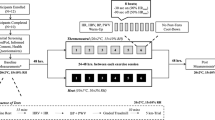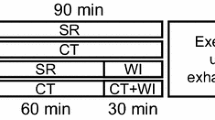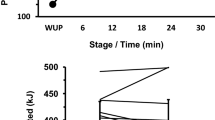Summary
Thirteen male volunteers performed cycle ergometer maximal oxygen uptake (\(\dot V_{{\text{O}}_{{\text{2max}}} }\)tests) in moderate (21‡ C, 30% rh) and hot (49‡ C, 20% rh) environments, before and after a 9-day heat acclimation program. This program resulted in significantly decreased (P<0.01) final heart rate (24 bt·min−1) and rectal temperature (0.4‡ C) from the first to last day of acclimation. The \(\dot V_{{\text{O}}_{{\text{2max}}} }\)was lower (P<0.01) in the hot environment relative to the moderate environment both before (8%) and after (7%) acclimation with no significant difference (P>0.05) shown for maximal power output (PO max, watts) between environments either before or after acclimation. The \(\dot V_{{\text{O}}_{{\text{2max}}} }\)was higher (P<0.01) by 4% after acclimation in both environments. Also, PO max was higher (P<0.05) after acclimation in both the moderate (4%) and hot (2%) environments. The reduction in \(\dot V_{{\text{O}}_{{\text{2max}}} }\)in the hot compared to moderate environment was not related to the difference in core temperature at \(\dot V_{{\text{O}}_{{\text{2max}}} }\)between moderate and hot trials, nor was it strongly related with aerobic fitness level. These findings indicate that heat stress, per se, reduced the \(\dot V_{{\text{O}}_{{\text{2max}}} }\). Further, the reduction in \(\dot V_{{\text{O}}_{{\text{2max}}} }\)due to heat was not affect be state of heat acclimation, the degree of elevation in core temperature, or level of aerobic fitness.
Similar content being viewed by others
References
åstrand P-O, Rodahl K (1977) Textbook of Work Physiology. McGraw-Hill, New York
Davies CTM (1979) Influence of skin temperature on sweating and aerobic performance during severe work. J Appl Physiol: Respirat Environ Exercise Physiol 47: 770–777
Davies CTM, Brotherhood JR, Zeidifard D (1976) Temperature regulation during severe exercise with some observations on effects of skin wetting. J Appl Physiol 41: 772–776
Desai JB, Senay LC (1984) Influence of endurance training and heat acclimation on blood volume and maximal aerobic capacity. Fed Proc [Abstract] 43: 627
Kamon E, Pandolf KB (1972) Maximal aerobic power during laddermill climbing, uphill running and cycling. J Appl Physiol 32: 467–473
Klausen KD, Dill DB, Phillips EE, McGregor D (1967) Metabolic reactions to work in the desert. J Appl Physiol 22: 292–296
Nadel ER, Pandolf KB, Roberts MF, Stolwijk JAP (1974) Mechanism of thermal acclimation to exercise and heat. J Appl Physiol 37: 515–520
Pollock ML (1973) The quantification of endurance training programs. In: Wilmore JH (ed) Exercise and sport sciences reviews, vol I. Academic Press, New York, pp 155–188
Roberts MF, Wenger CB, Stolwijk JAJ, Nadel ER (1977) Skin blood flow and sweating changes following exercise training and heat acclimation. J Appl Physiol: Respirat Environ Exercise Physiol 43: 133–137
Rowell LB (1983) Cardiovascular aspects of human thermoregulation. Circ Res 52: 367–379
Rowell LB, Blackman JR, Martin RH, Mazzarella JA, Bruce RA (1965) Hepatic clearance of indocyanine green in man under thermal and exercise stresses. J Appl Physiol 20: 384–394
Rowell LB, Brengelmann GL, Murray JA, Kraning KK, Kusumi F (1969) Human metabolic responses to hyperthermia during mild to maximal exercise. J Appl Physiol 26: 395–402
Rowell LB, Marx HJ, Bruce RA, Conn RD, Kusumi F (1966) Reductions in cardiac output, central blood volume and stroke volume with thermal stress in normal men during exercise. J Clin Invest 45: 1801–1816
Saltin B, Hermansen L (1966) Esophageal, rectal and muscle temperature during exercise. J Appl Physiol 21: 1757–1762
Saltin B, Gagge AP, Bergh U, Stolwijk JAJ (1972) Body temperatures and sweating during exhaustive exercise. J Appl Physiol 32: 635–643
Williams CG, Bredell GAG, Wyndham CH, Strydom NB, Morrison JF, Peter J, Fleming PW, Ward JS (1962) Circuatory and metabolic reactions to work in heat. J Appl Physiol 17: 625–638
Winer BJ (1971) Statistical principles in experimental design. McGraw-Hill, New York
Wyndham CH, Benade AJS, Williams CG, Strydom NB, Goldin A, Heyns AJA (1968) Changes in central circulation and body fluid spaces during acclimatization to heat. J Appl Physiol 25: 586–593
Wyndham CH, Rogers GC, Senay LC, Mitchell D (1976) Acclimatization in a hot, humid environment: cardiovascular adjustments. J Appl Physiol 40: 779–785
Wyndham CH, Strydom NB, Benade AJS, van Rensburg AJ, Rogers GG (1972) Heat stroke risks in unacclimatized and acclimatized men of different maximum oxygen intakes working under hot and humid conditions. Chamber of Mines of South Africa, Project No. 19/A720.64
Young AJ, Evans WJ, Cymerman A, Pandolf KB, Knapik JJ, Maher JT (1982) Sparing effect of chronic high altitude exposure on muscle glycogen utilization. J Appl Physiol: Respirat Environ Exercise Physiol 52: 857–862
Author information
Authors and Affiliations
Rights and permissions
About this article
Cite this article
Sawka, M.N., Young, A.J., Cadarette, B.S. et al. Influence of heat stress and acclimation on maximal aerobic power. Europ. J. Appl. Physiol. 53, 294–298 (1985). https://doi.org/10.1007/BF00422841
Accepted:
Issue Date:
DOI: https://doi.org/10.1007/BF00422841




